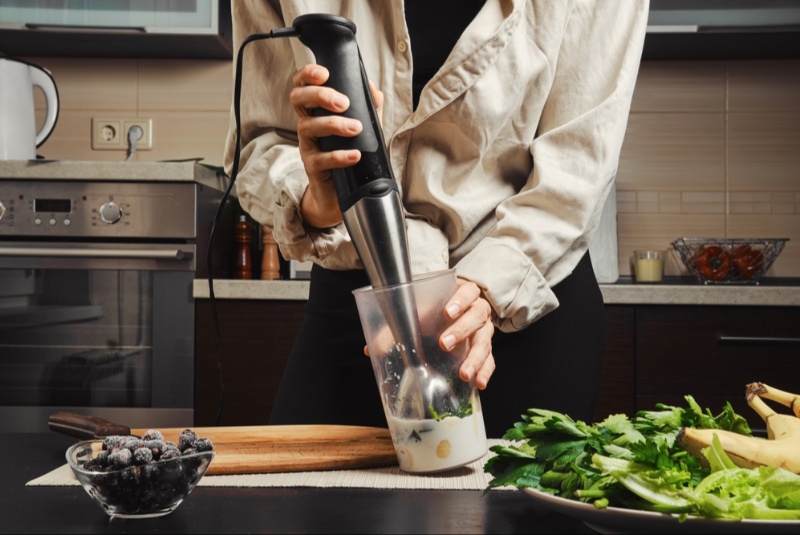Hand blenders, also known as immersion or stick blenders, are a versatile and convenient tool for any kitchen. Perfect for blending soups, sauces, smoothies, and more, they offer ease of use and quick cleanup. This guide will help you choose the perfect hand blender, balancing functionality, power, design, and price.
Understanding Hand Blender Basics
A hand blender is a compact, handheld appliance with a blending blade at one end and a motor at the other. Unlike traditional blenders, they allow you to blend directly in the pot, bowl, or glass, making them incredibly convenient for a variety of kitchen tasks.
Evaluating Motor Power and Speed Settings
Motor power, measured in watts, is a key factor in determining a hand blender's performance. A higher wattage typically means more power and efficiency in blending tougher ingredients. Also, consider blenders with multiple speed settings, as they offer greater control for different types of blending tasks.
Blade Design and Material Quality
The design and material of the blade affect the blender's efficiency and longevity. Stainless steel blades are durable and resistant to rust and corrosion. Some models feature specially designed blades that can enhance blending efficiency and result in smoother textures.
Comfort and Ergonomics
Since hand blenders are handheld appliances, comfort and ergonomics are crucial. Look for models with a comfortable grip and an easy-to-reach power button. A lighter model will reduce hand fatigue, especially when blending for extended periods.
Size and Storage Considerations
Consider the size of the hand blender and the space available for storage. Some models come with detachable shafts or compact designs that are easier to store. If kitchen space is limited, look for a model that strikes a balance between size and functionality.
Versatility and Attachments
Some hand blenders come with attachments like whisks, choppers, or interchangeable blades, making them more versatile. If you plan to use the blender for a variety of tasks, consider a model that comes with these additional attachments.
Ease of Cleaning
Ease of cleaning is an important consideration for any kitchen appliance. Look for hand blenders with detachable shafts or parts that are dishwasher-safe. This will save time and ensure the blender remains hygienic for each use.
Durability and Build Quality
A high-quality hand blender should be durable and built to last. Check the build quality of both the motor housing and the blending shaft. A warranty can also be a good indicator of the manufacturer's confidence in their product.
Noise Level
Hand blenders vary in the amount of noise they produce. If you are sensitive to noise or live in a household where quiet is important, look for models that are designed to operate more quietly.
Safety Features
Safety is an important aspect of any electrical kitchen appliance. Look for hand blenders with safety locks or guards that prevent accidental blade activation. This is particularly important in households with children.

Balancing Cost with Features
Hand blenders range from basic, budget-friendly models to high-end appliances with additional features. Determine your budget and what features are essential for your cooking needs. Investing in a slightly more expensive model with better quality and more features can be cost-effective in the long run.
Adapting to Different Cooking Styles and Recipes
When selecting a hand blender, consider how it will adapt to your specific cooking style and the variety of recipes you frequently prepare. If you often make soups, sauces, or purees directly in the pot, look for a hand blender with a longer shaft to reach deeper pots. For those who enjoy making smoothies or protein shakes, a model with a powerful motor to crush ice and blend frozen fruits is ideal. Additionally, if baking is a passion, attachments like a whisk can be incredibly helpful. Matching the hand blender's capabilities with your culinary habits ensures that it becomes an indispensable tool in your kitchen.
The Role of Aesthetics in Kitchen Appliance Selection
While functionality is paramount in choosing a hand blender, aesthetics also play a significant role, especially in modern kitchens where appliances often remain on display. Many brands offer hand blenders in various colors and finishes, allowing you to choose one that complements your kitchen's décor and personal style. A well-designed hand blender can add a touch of elegance to your kitchen, besides being a practical tool. Consider how the blender will look alongside other appliances, and choose a design that resonates with your kitchen's aesthetic and your personal taste.
Reading Reviews and Seeking Recommendations
Before purchasing a hand blender, read online reviews and ask for recommendations from friends or cooking forums. Reviews can provide insights into the real-world performance and durability of the blender. Pay attention to comments about long-term use and reliability.
Testing the Blender Before Purchase
If possible, try the hand blender in-store to assess its weight, comfort, and ease of use. Testing it firsthand can provide a better idea of how it feels to operate and whether it meets your expectations.
Considering Environmental Impact
For environmentally conscious consumers, consider the environmental impact of the hand blender. Look for energy-efficient models or those made from sustainable or recyclable materials. Opting for a durable and long-lasting blender also reduces waste and environmental impact over time.
Choosing the perfect hand blender involves considering factors like motor power, blade quality, ergonomics, size, versatility, ease of cleaning, durability, noise level, safety, cost, and environmental impact. By carefully evaluating these aspects and doing your research, you can find a hand blender that not only suits your kitchen needs but also enhances your cooking experience.




